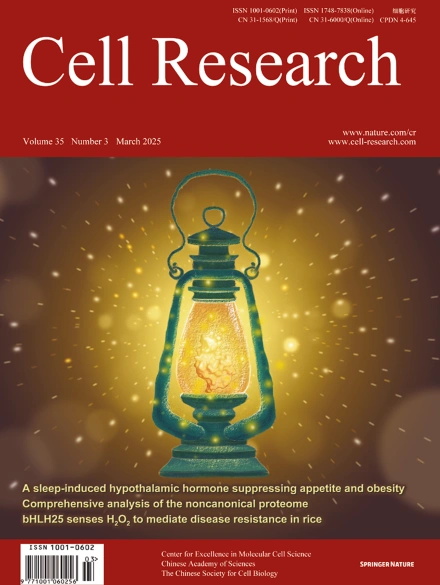
Advanced Search
Submit Manuscript
Advanced Search
Submit Manuscript
Volume 35, No 3, Mar 2025
ISSN: 1001-0602
EISSN: 1748-7838 2018
impact factor 17.848*
(Clarivate Analytics, 2019)
Volume 35 Issue 3, March 2025: 186-204 |
Comprehensive discovery and functional characterization of the noncanonical proteome
Chengyu Shi1,2,3,4,† , Fangzhou Liu1,2,3,4,† , Xinwan Su1,2,3,4,† , Zuozhen Yang2,3,4 , Ying Wang2,3,4 , Shanshan Xie3,5,6 , Shaofang Xie7 , Qiang Sun1 , Yu Chen2,3,4 , Lingjie Sang2,3,4 , Manman Tan2,3,4 , Linyu Zhu2,3,4 , Kai Lei2,3,4 , Junhong Li2,3,4 , Jiecheng Yang2,3,4 , Zerui Gao2,3,4 , Meng Yu2,3,4 , Xinyi Wang2,3,4 , Junfeng Wang2,3,4 , Jing Chen8 , Wei Zhuo3,5,6 , Zhaoyuan Fang9,10 , Jian Liu9,11 , Qingfeng Yan2 , Dante Neculai1 , Qiming Sun1 , Jianzhong Shao2 , Weiqiang Lin12 , Wei Liu1 , Jian Chen3,8 , Liangjing Wang6 , Yang Liu13 , Xu Li7 , Tianhua Zhou1,3,5,14,* , Aifu Lin1,2,3,4,15,16,*
1The Center for RNA Medicine, International Institutes of Medicine, International School of Medicine, The 4th Affiliated Hospital of Zhejiang University School of Medicine, Yiwu, Zhejiang, ChinaThe systematic identification and functional characterization of noncanonical translation products, such as novel peptides, will facilitate the understanding of the human genome and provide new insights into cell biology. Here, we constructed a high-coverage peptide sequencing reference library with 11,668,944 open reading frames and employed an ultrafiltration tandem mass spectrometry assay to identify novel peptides. Through these methods, we discovered 8945 previously unannotated peptides from normal gastric tissues, gastric cancer tissues and cell lines, nearly half of which were derived from noncoding RNAs. Moreover, our CRISPR screening revealed that 1161 peptides are involved in tumor cell proliferation. The presence and physiological function of a subset of these peptides, selected based on screening scores, amino acid length, and various indicators, were verified through Flag-knockin and multiple other methods. To further characterize the potential regulatory mechanisms involved, we constructed a framework based on artificial intelligence structure prediction and peptide‒protein interaction network analysis for the top 100 candidates and revealed that these cancer-related peptides have diverse subcellular locations and participate in organelle-specific processes. Further investigation verified the interacting partners of pep1-nc-OLMALINC, pep5-nc-TRHDE-AS1, pep-nc-ZNF436-AS1 and pep2-nc-AC027045.3, and the functions of these peptides in mitochondrial complex assembly, energy metabolism, and cholesterol metabolism, respectively. We showed that pep5-nc-TRHDE-AS1 and pep2-nc-AC027045.3 had substantial impacts on tumor growth in xenograft models. Furthermore, the dysregulation of these four peptides is closely correlated with clinical prognosis. Taken together, our study provides a comprehensive characterization of the noncanonical proteome, and highlights critical roles of these previously unannotated peptides in cancer biology.
https://doi.org/10.1038/s41422-024-01059-3